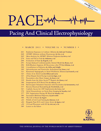Meta-Analysis to Assess the Appropriate Endpoint for Slow Pathway Ablation of Atrioventricular Nodal Reentrant Tachycardia
[Correction added after online publication 11-Nov-2010: Spelling of author's name has been updated.]
There are no conflicts of interest.
Abstract
Background: There are little data on the appropriate endpoint for slow pathway ablation that balances acceptable procedural times, recurrence rates, and complication rates. This study compared recurrence rates of three commonly utilized endpoints of slow pathway ablation for atrioventricular nodal reentrant tachycardia (AVNRT).
Methods: We performed a meta-analysis of AVNRT slow pathway ablation cohorts by searching electronic databases, the Internet, and conference proceedings. Inclusion criteria were age >18 years, >20 human subjects per study, primary AVNRT ablation, English language publication, and >1 month of follow-up. Data were analyzed with a fixed-effects model using Comprehensive Meta-Analysis software version 2.2.046 (Biostat, Englewood, NJ, USA).
Results: We included 10 studies encompassing 1,204 patients with a mean age of 41–53 years. Endpoints were complete slow pathway ablation, residual jump only, and single remaining echo beat. Pooled estimates revealed 28 of 641 patients (4.4%) with complete slow pathway ablation, 13 of 192 patients (6.8%) with a residual jump only, and 24 of 371 patients (6.5%) with one echo had recurrences. With uniform isoproterenol use after ablation, there was no significant difference in recurrence rates among the endpoints. However, when isoproterenol was utilized after ablation only if needed to induce AVNRT before ablation, a significantly higher recurrence rate occurred in patients with a residual jump (P = 0.002), a single echo (P = 0.003), or the combined group of a residual jump and/or one echo (P = 0.001).
Conclusions: Isoproterenol should be used routinely after slow pathway modification, when a residual jump and/or single echo remain. (PACE 2011; 34:269–277)




